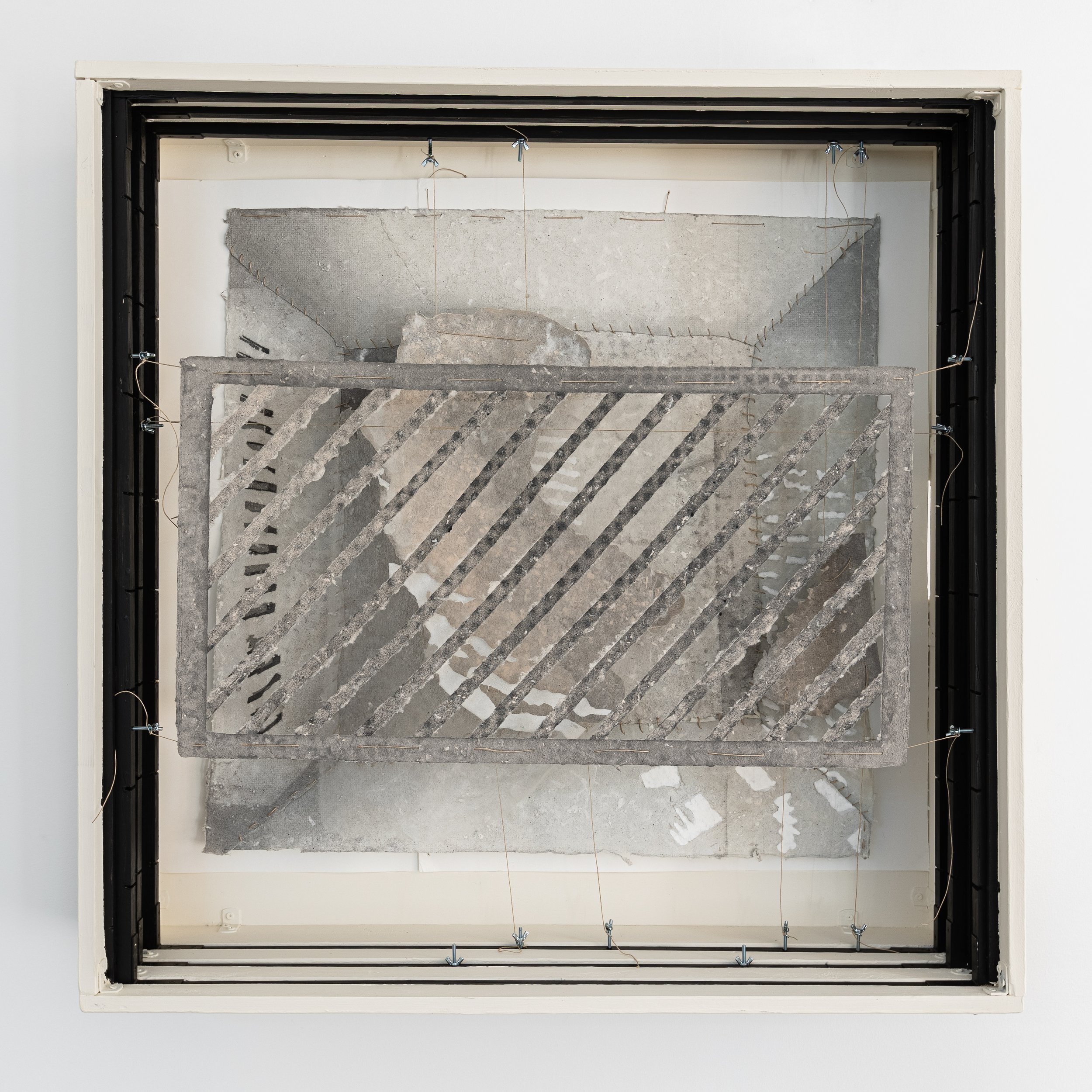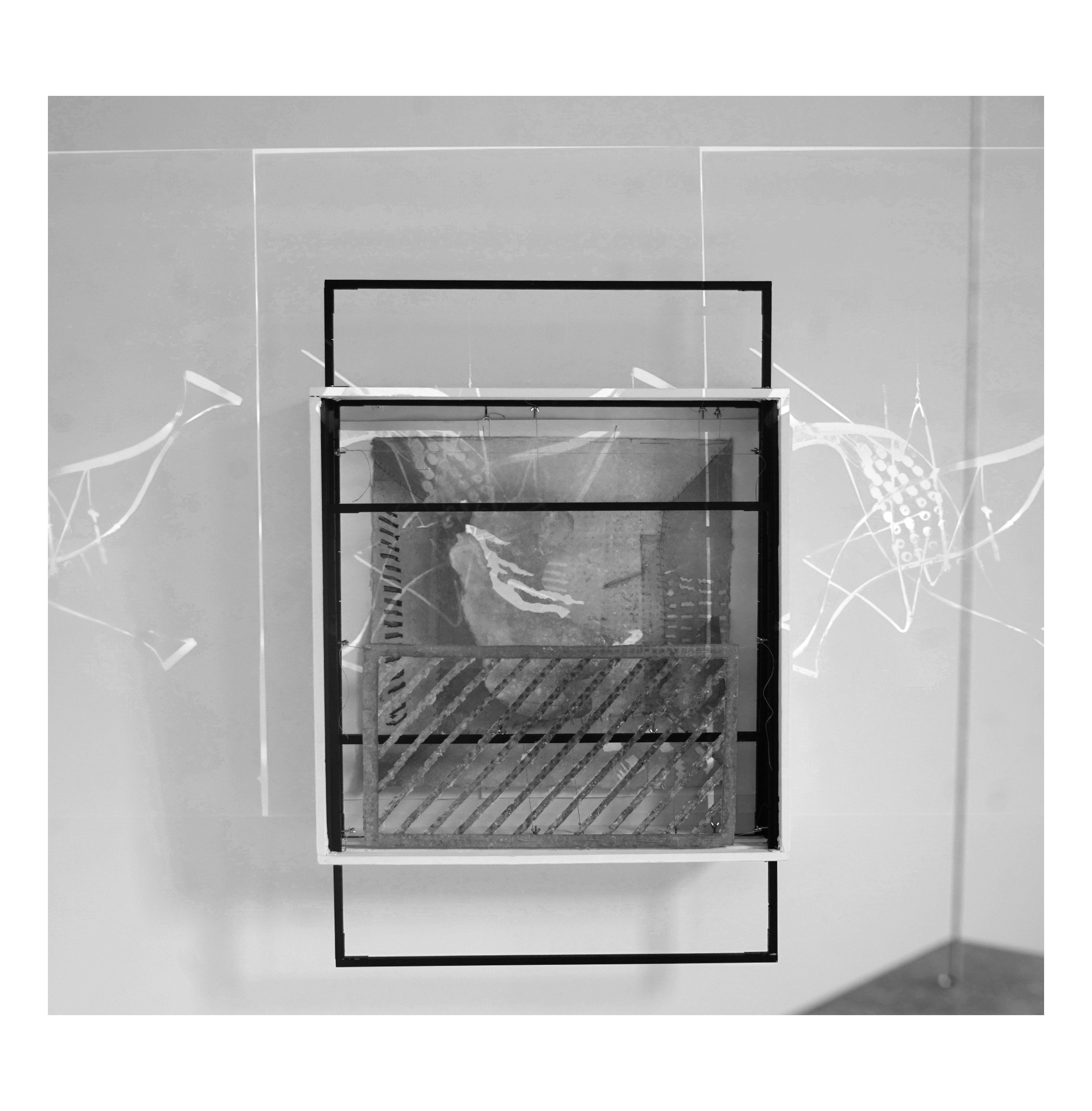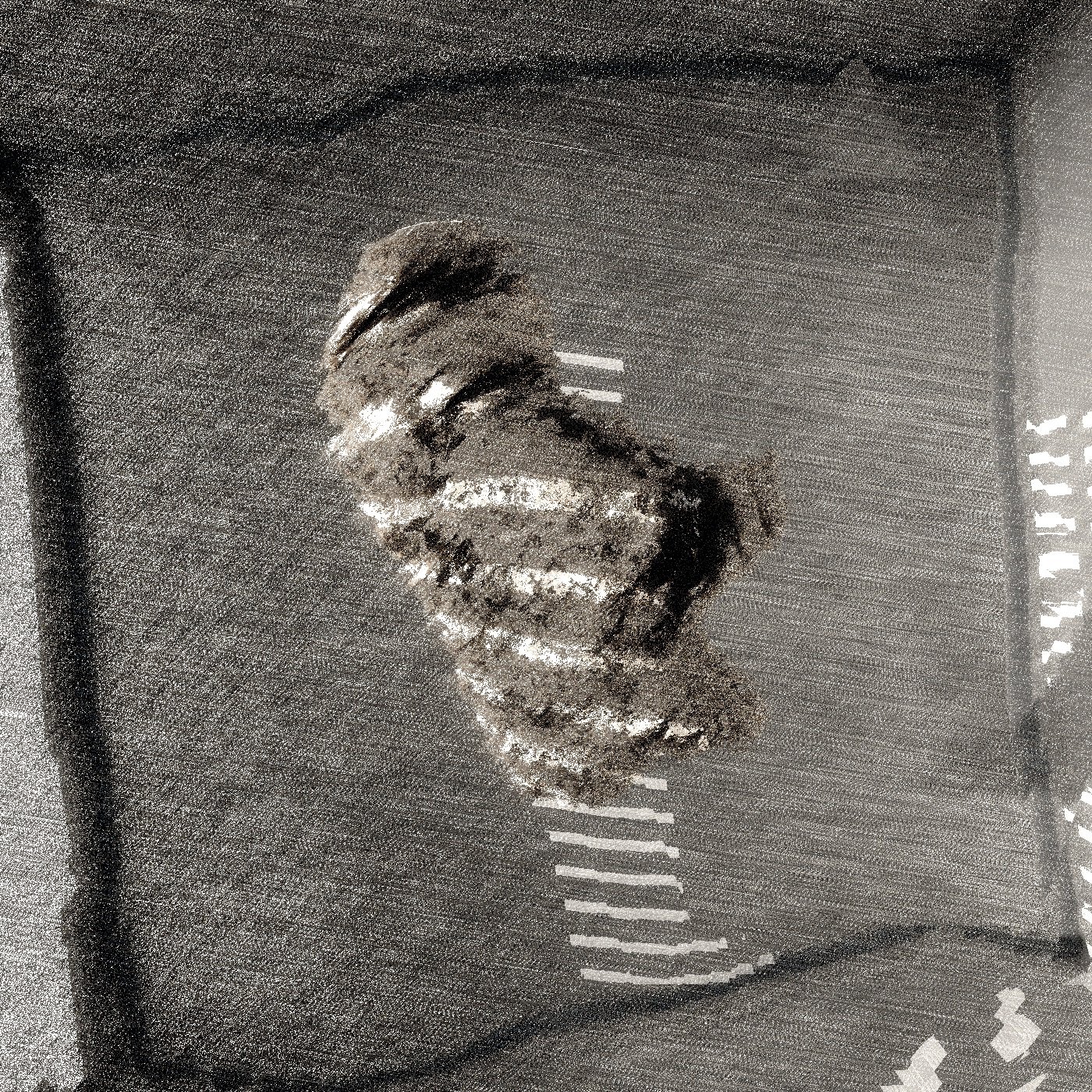identity space through light and three layers: a digital/analog study, 2024 by Marcelo Soria-Rodríguez
By Marcelo Soria-Rodríguez
Handmade paperwork via leafcasting (cotton and linen fibers, natural dyes) with handmade container (pinewood, white paint)
Size: 90 x 93,6 x 26,6 cm
Unique
Description:
When invited to create an artwork that would establish a dialogue with the work of Laszlo Moholy-Nagy, it quickly becomes clear that one can only talk to a small portion of his legacy. I have always been interested in his light and space modulators, concepts that are close to my practice as well. I employ mathematically defined spaces and deform them, also numerically, to arrive at possible spaces that reflect on perception, how each person's own view of the world is different and necessarily affected by their own personal experience and nature. At the same time, I came across one particular photogram that caught my eye (Photogram Mondgesicht, 1926). I had been experimenting with the deformation / modulation of mathematical space to create head-like figures from just a sphere, and this photogram reminded me of many particular shapes that came of my experiments.
I decided to create an artwork that would show one of the images that reminded me of this photogram, exposing the image in a specific setting that would allow the exhibitor or owner to play with the artwork, modulating its aspect: I built a box with three vertically moving trays, each of them containing one layer of artwork. The main image is the head figure enclosed in a olume that has certain holes cut so that light enters in a particular way. (a light modulation in virtual space). Another layer is a recreation of the light rays that enter that volume. Another, final layer is a computer simulation of the shadows cast by the same type of holes, in a larger space with more holes. This creates a layer that partially conceals the image behind, forcing the viewer to get close to the artwork and move around to see behind completely.
My digital artworks are typically interactive, and I wanted to leave that possibility here as well. The viewer can choose to lift the layers or displace them to the point where they want. The reason for the interactivity lies in my generative work. In generative systems, the combination of parameters happens randomly, but a certain combination is not, so to speak, set in stone. Taking a random combination of parameters, controlled by the rules set by the artist, is only a starting point. I typically allow the user (in a digital work context) to change some parameter, play around with some controls, effectively adding more random (from the standpoint of the artist) input to the artwork. I wanted to expose certain degree of possibility as well in this physical artwork. The trays and the guides that contain them are left in their bare wood state, only slightly covered in irregular and thin paint, to portray what's fixed (the box with 3 openings for the trays) and what's changing (the trays). One could potentially choose to remove all the trays and leave the box. What is the artwork?
Also, the artwork layers are made with a technique called leaf-casting, where I create the layers by hand, employing differently coloured paper pulp and casting (almost sculpting) a paper to mimic the artwork that I created digitally using my algorithmic, generative techniques. This is a concept I have explored earlier, where the artwork is not transferred to paper, such as a print or a silkscreen, but rather the artwork is the paper itself, much like a sculpture. This plays with the notion of the origin of the ideas and thoughts that make up our identities: do we come up with them, or do they preexist?
In this sense, the artwork is not the digital image I create, but rather it is an idea that exists in a non-tangible plane, that takes shape in a digital image, a handmade paper, etc. The artwork will consist of 3 layers of handmade paper in this technique, attached to the trays using thread.
By Marcelo Soria-Rodríguez
Handmade paperwork via leafcasting (cotton and linen fibers, natural dyes) with handmade container (pinewood, white paint)
Size: 90 x 93,6 x 26,6 cm
Unique
Description:
When invited to create an artwork that would establish a dialogue with the work of Laszlo Moholy-Nagy, it quickly becomes clear that one can only talk to a small portion of his legacy. I have always been interested in his light and space modulators, concepts that are close to my practice as well. I employ mathematically defined spaces and deform them, also numerically, to arrive at possible spaces that reflect on perception, how each person's own view of the world is different and necessarily affected by their own personal experience and nature. At the same time, I came across one particular photogram that caught my eye (Photogram Mondgesicht, 1926). I had been experimenting with the deformation / modulation of mathematical space to create head-like figures from just a sphere, and this photogram reminded me of many particular shapes that came of my experiments.
I decided to create an artwork that would show one of the images that reminded me of this photogram, exposing the image in a specific setting that would allow the exhibitor or owner to play with the artwork, modulating its aspect: I built a box with three vertically moving trays, each of them containing one layer of artwork. The main image is the head figure enclosed in a olume that has certain holes cut so that light enters in a particular way. (a light modulation in virtual space). Another layer is a recreation of the light rays that enter that volume. Another, final layer is a computer simulation of the shadows cast by the same type of holes, in a larger space with more holes. This creates a layer that partially conceals the image behind, forcing the viewer to get close to the artwork and move around to see behind completely.
My digital artworks are typically interactive, and I wanted to leave that possibility here as well. The viewer can choose to lift the layers or displace them to the point where they want. The reason for the interactivity lies in my generative work. In generative systems, the combination of parameters happens randomly, but a certain combination is not, so to speak, set in stone. Taking a random combination of parameters, controlled by the rules set by the artist, is only a starting point. I typically allow the user (in a digital work context) to change some parameter, play around with some controls, effectively adding more random (from the standpoint of the artist) input to the artwork. I wanted to expose certain degree of possibility as well in this physical artwork. The trays and the guides that contain them are left in their bare wood state, only slightly covered in irregular and thin paint, to portray what's fixed (the box with 3 openings for the trays) and what's changing (the trays). One could potentially choose to remove all the trays and leave the box. What is the artwork?
Also, the artwork layers are made with a technique called leaf-casting, where I create the layers by hand, employing differently coloured paper pulp and casting (almost sculpting) a paper to mimic the artwork that I created digitally using my algorithmic, generative techniques. This is a concept I have explored earlier, where the artwork is not transferred to paper, such as a print or a silkscreen, but rather the artwork is the paper itself, much like a sculpture. This plays with the notion of the origin of the ideas and thoughts that make up our identities: do we come up with them, or do they preexist?
In this sense, the artwork is not the digital image I create, but rather it is an idea that exists in a non-tangible plane, that takes shape in a digital image, a handmade paper, etc. The artwork will consist of 3 layers of handmade paper in this technique, attached to the trays using thread.
By Marcelo Soria-Rodríguez
Handmade paperwork via leafcasting (cotton and linen fibers, natural dyes) with handmade container (pinewood, white paint)
Size: 90 x 93,6 x 26,6 cm
Unique
Description:
When invited to create an artwork that would establish a dialogue with the work of Laszlo Moholy-Nagy, it quickly becomes clear that one can only talk to a small portion of his legacy. I have always been interested in his light and space modulators, concepts that are close to my practice as well. I employ mathematically defined spaces and deform them, also numerically, to arrive at possible spaces that reflect on perception, how each person's own view of the world is different and necessarily affected by their own personal experience and nature. At the same time, I came across one particular photogram that caught my eye (Photogram Mondgesicht, 1926). I had been experimenting with the deformation / modulation of mathematical space to create head-like figures from just a sphere, and this photogram reminded me of many particular shapes that came of my experiments.
I decided to create an artwork that would show one of the images that reminded me of this photogram, exposing the image in a specific setting that would allow the exhibitor or owner to play with the artwork, modulating its aspect: I built a box with three vertically moving trays, each of them containing one layer of artwork. The main image is the head figure enclosed in a olume that has certain holes cut so that light enters in a particular way. (a light modulation in virtual space). Another layer is a recreation of the light rays that enter that volume. Another, final layer is a computer simulation of the shadows cast by the same type of holes, in a larger space with more holes. This creates a layer that partially conceals the image behind, forcing the viewer to get close to the artwork and move around to see behind completely.
My digital artworks are typically interactive, and I wanted to leave that possibility here as well. The viewer can choose to lift the layers or displace them to the point where they want. The reason for the interactivity lies in my generative work. In generative systems, the combination of parameters happens randomly, but a certain combination is not, so to speak, set in stone. Taking a random combination of parameters, controlled by the rules set by the artist, is only a starting point. I typically allow the user (in a digital work context) to change some parameter, play around with some controls, effectively adding more random (from the standpoint of the artist) input to the artwork. I wanted to expose certain degree of possibility as well in this physical artwork. The trays and the guides that contain them are left in their bare wood state, only slightly covered in irregular and thin paint, to portray what's fixed (the box with 3 openings for the trays) and what's changing (the trays). One could potentially choose to remove all the trays and leave the box. What is the artwork?
Also, the artwork layers are made with a technique called leaf-casting, where I create the layers by hand, employing differently coloured paper pulp and casting (almost sculpting) a paper to mimic the artwork that I created digitally using my algorithmic, generative techniques. This is a concept I have explored earlier, where the artwork is not transferred to paper, such as a print or a silkscreen, but rather the artwork is the paper itself, much like a sculpture. This plays with the notion of the origin of the ideas and thoughts that make up our identities: do we come up with them, or do they preexist?
In this sense, the artwork is not the digital image I create, but rather it is an idea that exists in a non-tangible plane, that takes shape in a digital image, a handmade paper, etc. The artwork will consist of 3 layers of handmade paper in this technique, attached to the trays using thread.



